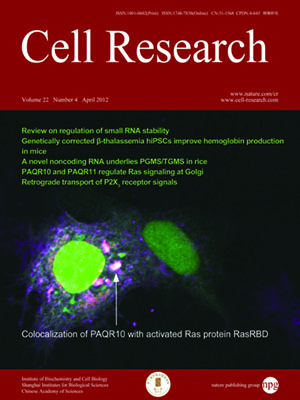
Volume 22, No 4, Apr 2012
ISSN: 1001-0602
EISSN: 1748-7838 2018
impact factor 17.848*
(Clarivate Analytics, 2019)
Volume 22 Issue 4, April 2012: 757-768
ORIGINAL ARTICLES
Molecular insights into the heterogeneity of telomere reprogramming in induced pluripotent stem cells
Fang Wang1, Yu Yin1, Xiaoying Ye1, Kai Liu1, Haiying Zhu2, Lingling Wang1, Maria Chiourea3, Maja Okuka4, Guangzhen Ji1, Jiameng Dan1, Bingfe
1College of Life Sciences, Nankai University, Tianjin 300071, China;
2Department of Genetics, Yale University School of Medicine, New Haven, CT 06520-8005, USA;
3Genetics Division, Biomedical Research Foundation of the Academy of Athens Greece (BRFAA), Athens 11527, Greece;
4Department of Obstetrics and Gynecology, University of South Florida College of Medicine, Tampa, FL 33612, USA;
5Department of Obstetrics and Gynecology, New York University Langone Medical Center, NY 10016, USA
Correspondence: Lin Liu,(liulin@nankai.edu.cn; liutelom@yahoo.com)
Rejuvenation of telomeres with various lengths has been found in induced pluripotent stem cells (iPSCs). Mechanisms of telomere length regulation during induction and proliferation of iPSCs remain elusive. We show that telomere dynamics are variable in mouse iPSCs during reprogramming and passage, and suggest that these differences likely result from multiple potential factors, including the telomerase machinery, telomerase-independent mechanisms and clonal influences including reexpression of exogenous reprogramming factors. Using a genetic model of telomerase-deficient (Terc
−/− and Terc
+/−) cells for derivation and passages of iPSCs, we found that telomerase plays a critical role in reprogramming and self-renewal of iPSCs. Further, telomerase maintenance of telomeres is necessary for induction of true pluripotency while the alternative pathway of elongation and maintenance by recombination is also required, but not sufficient. Together, several aspects of telomere biology may account for the variable telomere dynamics in iPSCs. Notably, the mechanisms employed to maintain telomeres during iPSC reprogramming are very similar to those of embryonic stem cells. These findings may also relate to the cloning field where these mechanisms could be responsible for telomere heterogeneity after nuclear reprogramming by somatic cell nuclear transfer.
Cell Research (2012) 22:757-768. doi:10.1038/cr.2011.201; published online 20 December 2011
FULL TEXT | PDF
Browse 2123


